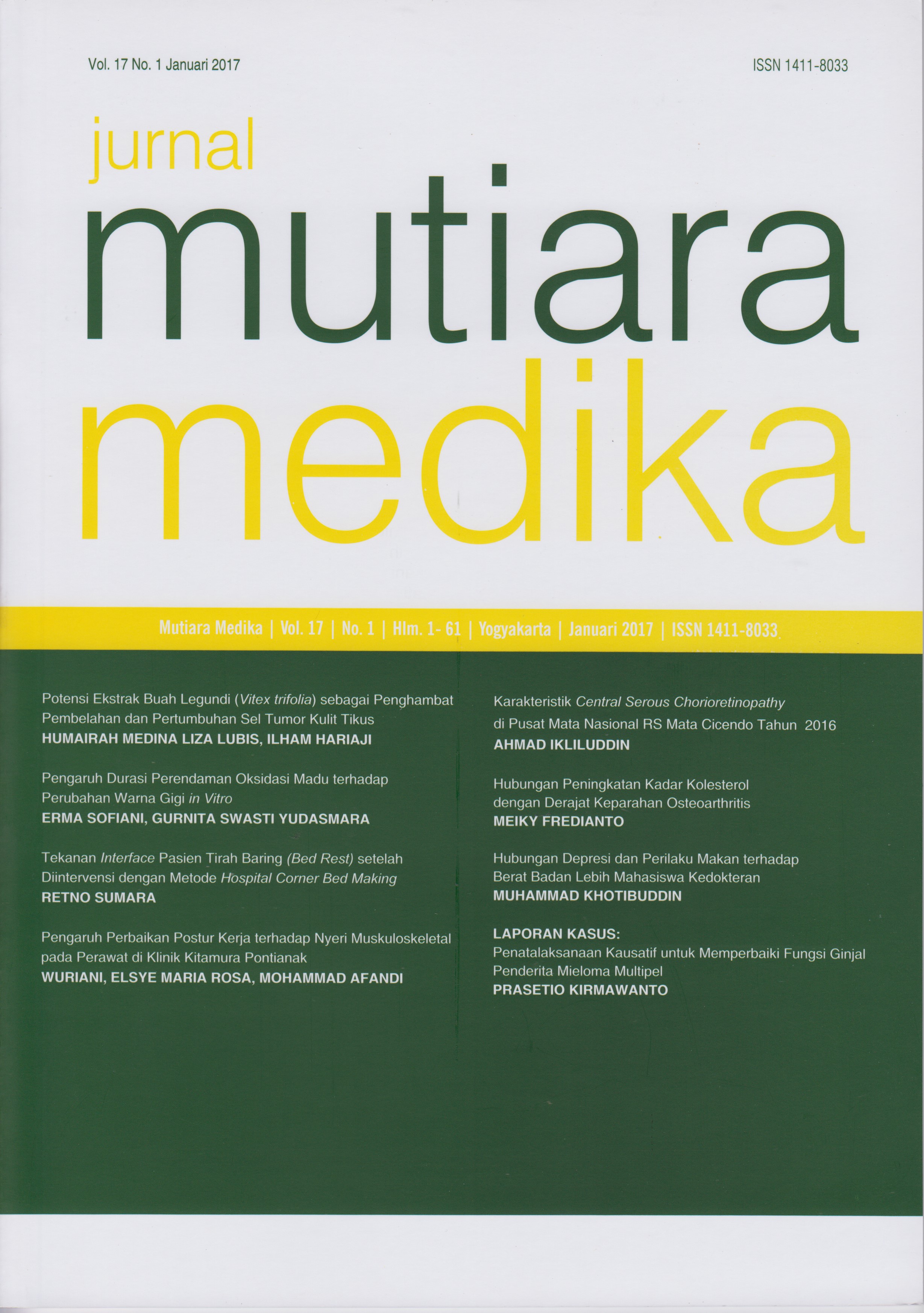Tekanan Interface Pasien Tirah Baring (Bed Rest) Setelah Diintervensi dengan metode Hospital Corner Bed Making
DOI:
https://doi.org/10.18196/mmjkk.v17i1.3678Keywords:
bedrest, interface pressure, hospital corner bed making, pressure ulcer, tirah baring, tekanan interface, luka tekanAbstract
Pasien tirah baring jangka lama berisiko mengalami gangguan integritas kulit. Gangguan tersebut dapat diakibatkan oleh tekanan yang lama, iritasi kulit atau imobilisasi (bed rest) yang berakibat timbulnya luka dekubitus. Pasien tirah baring membutuhkan intervensi yang difokuskan pada life support atau organ support yang membutuhkan observasi intensif. Upaya pencegahan luka tekan dilakukan sedini mungkin antara lain dengan pemberian dukungan permukaan (interface pressure). Nilai tekanan interface tinggi berisiko timbulnya ulkus tekanan. Penelitian ini bertujuan mengidentifikasi tekanan interface pada pasien tirah baring. Metode penelitian eksperimental kuasi dengan pre-post test design. Jumlah sampel 48 responden terdiri dari 2 kelompok yaitu kelompok perlakuan diintervensi menggunakan metode hospital corner bed making dan kelompok kontrol diintervensi dengan metode bed making tali sudut. Kedua kelompok dilakukan evaluasi selama 3 hari. Instrumen yang digunakan adalah Portable Interface Pressure sensor: Palm Q. Hasil menunjukkan bahwa perubahan tekanan interface pre dan post pada kelompok kontrol cukup tinggi dan mengalami naik-turun yang bervariatif sehingga lebih berisiko mengalami luka tekan, sedangkan pada kelompok perlakuan cenderung mengalami penurunan dan atau stabil. Disimpulkan bahwa tekanan interface pada metode hospital corner bed making tampak lebih rendah daripada metode bed making tali sudut.
References
Perry, A.G., Potter, P.A. (2005). Fundamental of nursing: concepts, process, and practice. (6th ed.). St.Louis: Mosby
EPUAP, NPUAP. (2009). Pressure Ulcer Prevention Quick Reference Guide. Dikases di http://www.epuap.org/guidelines/ tanggal 22 Juni 2013.
Virani, Tazim et al. 2011 . Nursing Best Practice Guideline: Risk assessment and prevention of pressure ulcers. Registered Nurses’ Association of Ontario. Diakses di http://rnao.ca/bpg/guidelines/risk-assessment-and-preventionpressure-ulcers tanggal 07 Juli 2013.
Suriadi, Hiromi Sanada, et al. (2007). Risk factors in the development of pressure ulcers in an intensive care unit in Pontianak, Indonesia. International Wound Journal, 4(3), 208 – 215.
Tissue Viability Society. (2010). Laboratory measurement of the interface pressures applied by active therapy support surfaces. Journal of Tissue Viability. Volume 19, 2-6. Diakses http://www.journaloftissueviability.com/ Tanggal 25 Juni 2013.
Bryant, Ruth A; Denise. (2007). Acute : Chronic Wound ; Current Manajement Concepts third edition. Philadelphia. Elsevier
Abdullah, Mikrajuddin. 2004. IPA FISIKA 2 . PT. Gelora Aksara Pratama. Diakses di http://books.google.co.id/books tanggal 22 desemcer 2013.
Wound, Ostomy, and Continence Nurse Society. (2003). Guideline for management of pressure ulcer, WOCN Clinical Practice Guideline Series 2. Glenview. III. Author. Diakses di www.Wocn.org/ tanggal 23 Oktober 2013.
Kenneth, Wright. 2010. A Self - Help Guide Pressure Ulcers Prevention And Treatment. Mediscript Communications Inc. Diakses pada tanggal 9 desember 2013 . www.dmsystems. com/pdf/PUSelfHelpGuide.pdf .
Keller et al, 2005. Tissue Interface Pressures On Three Different Support Surfaces For Trauma Patients. INJURY: international journal of the care of the injured. (36), 946 – 948. Diakses di www.elseiver.com tanggal 22 Desember 2013.
Lamberts. (2005). The Value of Pressure Ulcer Risk Assessment and Interface Pressure Measurements in Patients A nursing perspective. J.T.M. Weststrate, Department of Surgery, Rotterdam, the Netherlands. Diakses di repub.eur.nl/res/pub/7208/050425_Weststrate-J.pdf tanggal 33 Juni 2013.
Defloor T. 2000. The effect of position and mattress on interface pressure. Applied Nursing Research: ANR. Feb ; 13(1): 2 - 11. Diakses http://www.ncbi.nlm.nih.gov/pubmed/10701278# 21 Desember 2013.
Colin D, et al (1996) . Comparison of 90° and30° laterally inclined positions in the prevention of pressure ulcers using transcutaneous oxygen and carbon. Adv Wound Care, 9(3):35-8. http://www.ncbi.nlm.nih.gov/pubmed/8716272 Tanggal 28 Juni 2013.
Call, Evan; Baker, Loyal (2007) . How does bed frame design influence tissue interface pressure? A comparison of four different technologies designed for long-term or home care. Journal of Tissue Viability 17, 22-29. Diakses http://www.journaloftissueviability.com/ Tanggal 25 Juni 2013.
Effects On Air Mattress Pressure Redistribution Caused By Differences In Bed Making. Matsuo Junko; Sugama Junko; Okuwa Mayumi; Konya Chizuko; Sanada Hiromi in21st Conference of the European Wound Management Association. EWMA 2011. Diakses di :http://ewma.org/fileadmin/user_upload/EWMA/pdf/tanggal 28 Juli 2013.
Joint Commission International. (2010). Joint Commission International Nursing Sensitive Care (NSC) Measures. Diakses di : http://www.jointcommissioninternational.org/common/PDFs/JCI%20Standards/International_Library_of_Measures/NSC_Measure_Details_090810.pdf. tanggal 3 januari 2014.
Downloads
Issue
Section
License
Copyright
Authors retain copyright and grant Mutiara Medika: Jurnal Kedokteran dan Kesehatan (MMJKK) the right of first publication with the work simultaneously licensed under an Attribution 4.0 International (CC BY 4.0) that allows others to remix, adapt and build upon the work with an acknowledgment of the work's authorship and of the initial publication in Mutiara Medika: Jurnal Kedokteran dan Kesehatan (MMJKK).
Authors are permitted to copy and redistribute the journal's published version of the work (e.g., post it to an institutional repository or publish it in a book), with an acknowledgment of its initial publication in Mutiara Medika: Jurnal Kedokteran dan Kesehatan (MMJKK).
License
Articles published in the Mutiara Medika: Jurnal Kedokteran dan Kesehatan (MMJKK) are licensed under an Attribution 4.0 International (CC BY 4.0) license. You are free to:
- Share — copy and redistribute the material in any medium or format.
- Adapt — remix, transform, and build upon the material for any purpose, even commercially.
This license is acceptable for Free Cultural Works. The licensor cannot revoke these freedoms as long as you follow the license terms. Under the following terms:
Attribution — You must give appropriate credit, provide a link to the license, and indicate if changes were made. You may do so in any reasonable manner, but not in any way that suggests the licensor endorses you or your use.
- No additional restrictions — You may not apply legal terms or technological measures that legally restrict others from doing anything the license permits.






